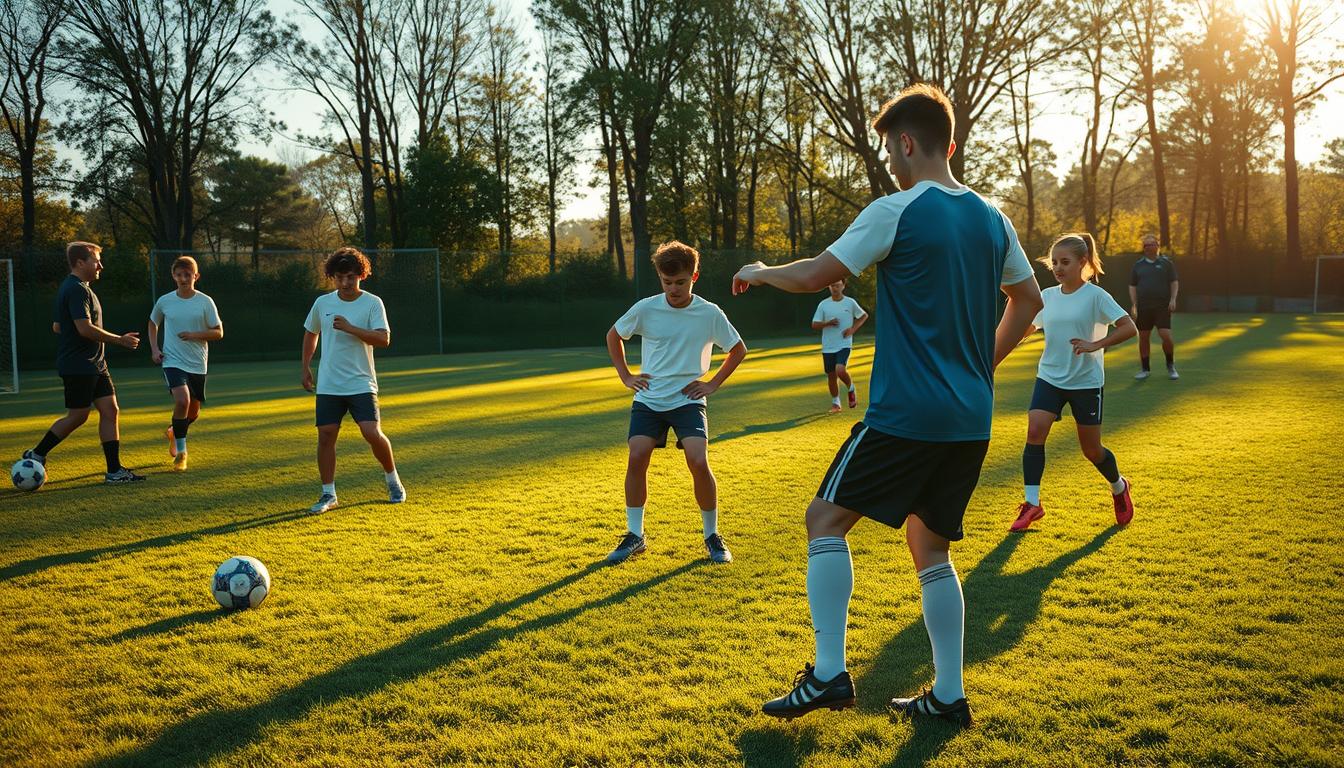Off-Season Training Plans for Kids

After months of intense games and practices, young athletes need a smart strategy to recharge without losing momentum. According to youth fitness expert Lucas Kruel, the off-season isn’t about sitting still—it’s about balancing rest with purposeful movement to rebuild strength and agility. The key? A gradual approach that keeps kids engaged while protecting their growing bodies from burnout or injuries.
Think of this time as a reset button. Instead of pushing hard drills or heavy workouts, focus on light conditioning, stability exercises, and fun activities that maintain fitness without strain. Proper sleep, nutrition, and controlled sessions help young players recover faster and return stronger. This article breaks down how to create a balanced week program that mixes rest days with skill-building—so your athlete stays energized for the next season.
Key Takeaways
- Rest and recovery are just as important as active training during the off-season.
- A mix of light conditioning, stability work, and fun drills prevents injuries.
- Sleep and nutrition play a critical role in rebuilding strength and endurance.
- Gradual exercise progression helps kids avoid burnout while staying game-ready.
- Balanced plans build long-term athletic skills without overwhelming young bodies.
Understanding the Off-Season: Rest and Recovery
Young players often overlook the value of stepping back after a demanding season. Research shows 1-2 weeks of full rest improves sleep quality by 30% and strengthens immunity. This pause lets muscles repair and minds reset, setting the stage for future growth.
Rest Strategies for Young Athletes
Start with 8-10 hours of nightly sleep—critical for recovery. Add 10-minute morning stretches to ease tight muscles. Swap intense drills for light walks or yoga. These low-impact sessions keep the body moving without strain.
Mental Rejuvenation and Relaxation
Encourage hobbies like art or music to shift focus from sport. Family board games or nature hikes rebuild emotional energy. Studies prove this mental break reduces injury risks by 22% when returning to training.
| Activity | Duration | Benefits |
|---|---|---|
| Deep Breathing | 5 minutes/day | Lowers stress hormones |
| Foam Rolling | 10 minutes | Improves muscle flexibility |
| Active Rest Days | 2 days/week | Maintains base fitness |
Balance is key. Alternate total rest days with gentle movement. This week program ensures athletes recharge fully before rebuilding strength and speed safely.
Laying the Foundations with Basic Exercises
Building a strong physical base starts with mastering simple movements that prep the body for future challenges. Focus on exercises requiring no equipment—just control and awareness. This approach builds muscle memory while reducing strain on developing joints.
Core Strength Fundamentals
Start with planks: hold for 20-30 seconds, keeping hips level. Add side planks or bird-dog poses to engage oblique muscles. These moves stabilize the trunk, improving balance during motor skills development.
Joint Stability Techniques
Single-leg balances strengthen ankles and knees. Try standing on one foot for 30 seconds, then switch. Mini-squats with proper knee alignment build lower-body endurance without weights. Always prioritize form over speed.
Aim for 2-3 days weekly of these exercises. Gradually increase duration by 10% each week. Consistent practice creates resilient athletes ready for advanced drills later in the season.
Reintroducing Ball Work and Soccer Skills
After taking time to rest, rebuilding technical skills starts with gentle ball activities that rebuild coordination. Think of this phase as a bridge—light enough to avoid strain but focused enough to sharpen muscle memory. The goal? Help players regain their rhythm while keeping sessions enjoyable.
Simple Drills for Touch and Control
Start with first-touch exercises using a wall or partner. Pass gently from 5 feet away, focusing on trapping the ball softly. Do 3 sets of 10 reps per foot. This rebuilds precision without overloading joints.
Next, try cone dribbling at half-speed. Set up 4 markers in a straight line, 3 feet apart. Weave through them using small touches, keeping the ball close. Repeat for 2 minutes, then rest. This drill improves close control—a skill that translates directly to game situations.
- Wall passes: 3x weekly to rebuild passing accuracy
- Stationary toe taps: 30-second bursts to boost foot-eye coordination
- Two-touch passing: Forces quick decision-making at safe speeds
Keep sessions short—20-30 minutes max—and always end with positive feedback. Gradually increase intensity over 2-3 weeks. This program helps young athletes return stronger while protecting their growing body from reinjury.
Increasing Workout Intensity Gradually
Progress feels great, but only when you match your pace to your body’s readiness for more. Pushing too hard too soon risks setbacks, while smart scaling builds lasting strength and confidence. Start by tracking how your muscles and energy levels respond after each session—this tells you when it’s safe to level up.

Monitoring Your Physical Readiness
Check for these signs before increasing effort: minimal soreness 24 hours post-workout, steady energy throughout the day, and no joint stiffness. If you’re exhausted or achy, stick with your current program another week. A simple journal helps track patterns over time.
Progressive Exercise Scaling
Add small challenges weekly. Try holding planks 5 seconds longer or doing 2 extra reps of bodyweight squats. For agility drills, shorten rest minutes by 10-15 seconds instead of rushing movements. This steady approach keeps gains consistent.
| Exercise | Week 1 | Week 2 | Week 3 |
|---|---|---|---|
| Plank Holds | 30 seconds | 35 seconds | 40 seconds |
| Bodyweight Squats | 10 reps | 12 reps | 15 reps |
| Agility Ladder Sets | 2 sets | 3 sets | 4 sets |
Safe and Enjoyable Challenges
Mix fun into your routine. Alternate speed drills with creative games like cone races or timed obstacle courses. Celebrate small wins—like beating your best ladder speed by half a second—to stay motivated. Always prioritize proper form over hitting numbers.
Remember: A 10% increase in effort per week keeps progress steady. Pair harder days with extra recovery activities like foam rolling or stretching. Your body will thank you!
Soccer off-season training plans for a Customized Week Program
Creating a tailored weekly routine keeps young players engaged while rebuilding their physical foundations. Youth coach Jenna Martinez suggests a 3-step framework: recovery days (30% effort), skill-building sessions (60% intensity), and one full rest day. This rhythm prevents burnout while maintaining progress.
Start by mapping out 7 days. Alternate light activities like swimming with focused drills. For example:
| Day | Focus | Duration |
|---|---|---|
| Monday | Active Recovery | 20 minutes |
| Tuesday | Ball Control | 25 minutes |
| Wednesday | Strength Circuits | 30 minutes |
| Thursday | Speed Drills | 20 minutes |
| Friday | Conditioning Games | 25 minutes |
| Saturday | Full Rest | – |
| Sunday | Fun Activity | 40 minutes |
Adjust durations based on age and fitness levels. Younger athletes might thrive with 15-minute sessions, while teens can handle 30-minute workouts. Always include 5-minute warm-ups and cool-downs.
Martinez emphasizes balancing three elements: technical drills (ball work), strength exercises (bodyweight moves), and conditioning (agility ladders). Rotate these throughout the week to keep things fresh. Track energy levels daily—if fatigue sets in, swap a drill for extra stretching.
Remember: Your plan should flex with your child’s needs. Swap Wednesday’s circuits for yoga if muscles feel tight. Replace Thursday’s speed work with relay races if motivation dips. The best program adapts as they grow!
Boosting Speed, Agility, and Strength
Building explosive power and sharp reflexes starts with smart drills that feel more like play than work. Pair short bursts of max effort with creative movement patterns to develop quickness while keeping sessions engaging. Consistency over weeks builds measurable improvements—without draining energy reserves.
Speed Drills for Quickness
Timed shuttle runs are perfect for testing progress. Mark three lines 10 yards apart. Sprint from line 1 to 2, touch the ground, then back to 1. Repeat for 20 seconds—rest 40 seconds. Do 5 sets twice weekly. Focus on explosive starts and sharp stops to mimic game scenarios.
Hill sprints add natural resistance. Find a gentle slope and sprint uphill for 8-10 seconds. Walk back down to recover. Start with 4 reps, increasing by one each week. This builds leg strength while improving acceleration.
Agility Workouts for Better Coordination
Set up an agility ladder flat on grass. Practice high-knee runs through each square, lifting feet quickly. Time yourself for 3 rounds—aim to beat your best by half a second. Alternate with lateral shuffles to train side-to-side movements.
Cone zigzags boost directional changes. Place 5 markers in a zigzag pattern 5 yards apart. Weave through them at 75% speed, cutting sharply around each cone. Gradually increase pace as coordination improves.
- Bodyweight squats (3×12 reps) strengthen legs for faster sprints
- Single-leg hops over small hurdles improve balance and power
- Plyometric jump sequences (like box jumps) build explosive energy
Track your times weekly using a stopwatch or phone app. Celebrate every 0.5-second improvement—small wins keep motivation high. Always warm up with dynamic stretches and cool down with light jogging to protect growing muscles.
Maintaining Recovery, Flexibility, and Nutrition
Keeping your body strong and ready requires more than just workouts—it’s about smart recovery and fueling right. Even during lighter training weeks, your muscles and joints need care to stay flexible and injury-free. Think of recovery as part of your program, not an afterthought.
Effective Recovery Techniques
Active recovery keeps your body primed without overloading it. Try dynamic stretches like leg swings or arm circles for 30 seconds each before light workouts. After sessions, use a foam roller on tight calves or quads for 5-10 minutes to improve blood flow. Ice baths (50-55°F for 8-10 minutes) reduce inflammation after intense days.
| Activity | Frequency | Benefit |
|---|---|---|
| Evening Stretching | Daily | Boosts flexibility |
| Hydration Check | Every 2 hours | Prevents cramps |
| Protein Snacks | Post-workout | Repairs muscles |
Nutrition plays a huge role. Aim for a mix of lean protein (chicken, beans) and complex carbs (oats, sweet potatoes) within 45 minutes of activity. Hydrate with water or electrolyte drinks—half your weight in ounces daily keeps energy steady.
Flexibility reduces injury risks by 34% in young athletes. Add yoga or Pilates 1-2 days weekly to your program. Pair these with light ball drills or agility games to keep skills sharp while letting your body heal. Remember: rest days are when growth happens!
Sealing Your Off-Season Success with Confidence
Your journey isn’t just about preparing—it’s about believing in the process. Combining rest, foundational exercises, and smart skill-building creates a rock-solid base for the season ahead. Every light jog, balanced meal, and foam-rolling session adds up to big results.
Review your progress weekly. Celebrate small wins, like holding a plank 5 seconds longer or nailing a new dribbling move. Mix fun challenges into your program—try backyard obstacle courses or relay races with friends. Consistency beats intensity every time.
Confidence grows when effort meets planning. Trust your body’s signals, adjust workouts as needed, and stay patient. You’ve built strength, sharpened skills, and prioritized recovery. Now’s the moment to own your growth.
Ready to shine? Take one last look at your week program, then step onto the field knowing you’ve earned this momentum. The next chapter starts with you—play bold, play smart, and let your hard work speak.
